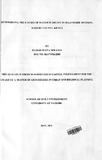| dc.description.abstract | Water exists as a scarce resource which is critical to social and economic development, and directly affects the behavior of society. In the next century, more than a quarter of the world's population, or a third of the population in developing countries live in areas that will experience severe water scarcity. The purpose of this study was to determine the causes of water scarcity in Maai Mahiu Division, Nakuru County. The study used mixed methods approach hence both survey and ethnographic designs have been used. Open ended and closed questionnaires were administered in the survey while open-response questions and the researchers' participation were design. The main sampling techniques used in the design were simple random sampling which was used to determine the households and water vendor respondents while snow balling was used in the selection of key informants. Questionnaires, observations, photography, images focus, group discussions and document analysis guide were used for data collection. The collected data was analyzed both descriptively and inferentially. The findings of the study reveal that; water sources are in existence either as surface water or as underground water and are affected by various factors which can be classified into human factors, environmental factors and the effect of climate change. Increased human settlement and population growth coupled by the activities that arise due to this two are the major human factors that contribute to water scarcity. Low rainfall, general aridity, low ground water supplies and the presence of few water bodies are the main environmental factors leading to water scarcity. The effects of climate change have resulted in weather variations, which is a contributing factor to water scarcity. The researcher concludes that, despite the presence of all this factors, water scarcity issue is one that can be addressed and tackled effectively if proper planning, encompassing water management and conservation as its core, is undertaken. The researcher recommends that rain water harvesting and water source conservation be undertaken as an immediate short-term measure to address the problem of water scarcity. The Government of Kenya, through the concerned agencies should create conservation buffer zones for the existing water sources and waterways as an integral long-term mitigation measure of addressing water scarcity. The research finally recommends that an integrated local development plan for Maai Mahiu be formulated and should put special attention on protecting, conserving and managing water resources for posterity. | en |

